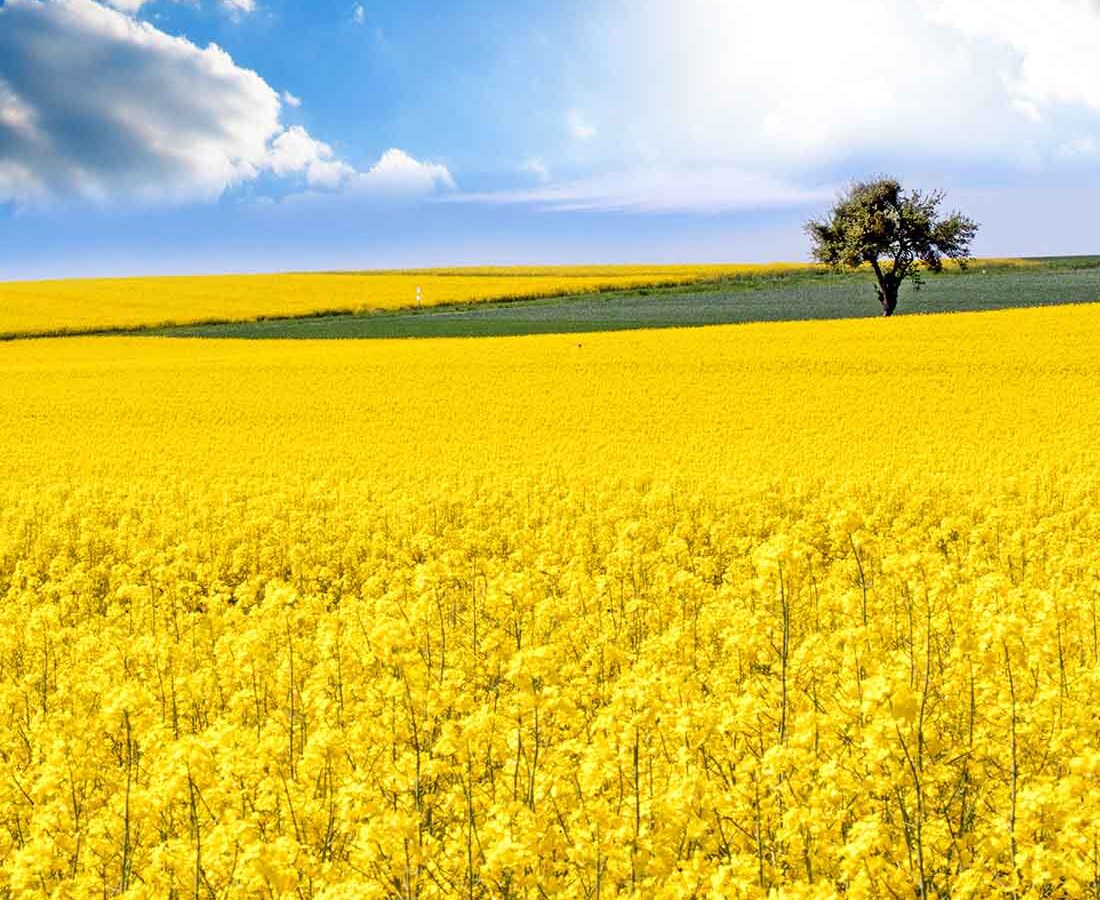After the last 12 months of market volatility the topic of nitrogen is still as hot as ever. Rocketing gas prices saw ammonium nitrate peak over £1000/t, with the wheat market reaching record highs as well.
Most growers have the bulk of their required nitrogen in the shed. However given the price per unit of nitrogen, the question of “how much nitrogen should we apply?” is more important than ever.
 Measuring the soil mineral nitrogen (SMN) levels on farm and calculating the farms soil nitrogen status (SNS) is one key component of answering this question. Within CCC we have therefore carried out deep N tests across a range of sites in the south of England with the aim to to get a better understanding of the soil mineral nitrogen (SMN) levels for the coming spring.
Measuring the soil mineral nitrogen (SMN) levels on farm and calculating the farms soil nitrogen status (SNS) is one key component of answering this question. Within CCC we have therefore carried out deep N tests across a range of sites in the south of England with the aim to to get a better understanding of the soil mineral nitrogen (SMN) levels for the coming spring.
*The SMN is the amount of nitrogen in the soil available to the crop.
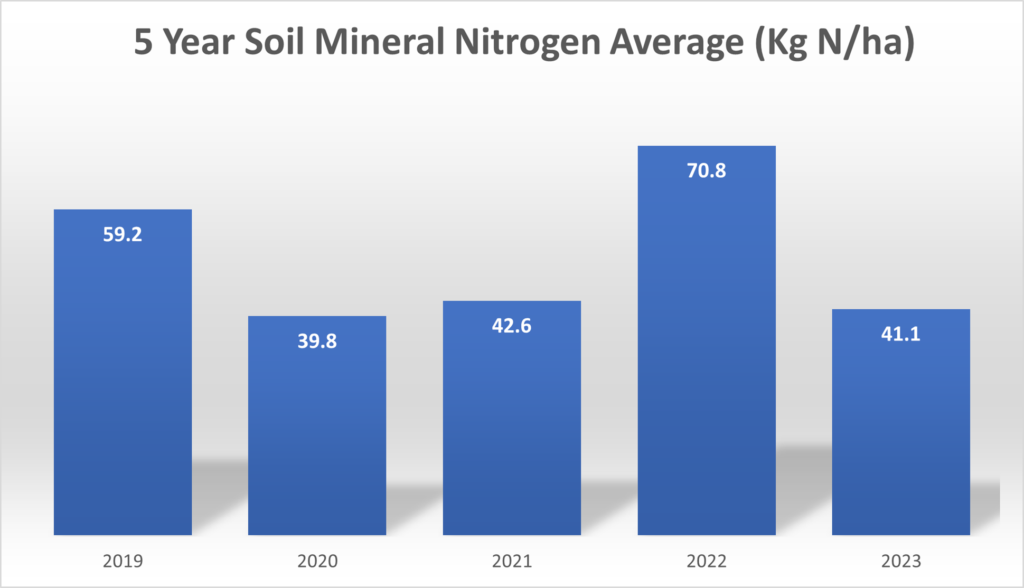
A total of 119 samples were taken across a range of sites in the south of England throughout February to help evaluate optimum nitrogen dose rates for the coming season. Across all sites the average SMN level came back at a low level of 41.1 kg N/ha. This is unsurprising given the amount of rainfall over the last 6 months, as well as most crops utilising nitrogen well last year.
On farm the SMN only makes up part of the picture, as the SNS index is calculated by measuring the amount of nitrogen in the growing crop, as well as calculating the amount that will be mineralised through the growing season. This will be different for each farm and soil type, however on average most farms are at an Index 1, which means farms are less likely to be able to reduce nitrogen rates this year in most instances. Where manures have regularly been applied indices may be higher and this may give an opportunity to reduce the amount of N applied this year.
Despite much of the east of England crying out for rain, between the period of June 2022 and February 2023 the south of England accumulated a total of 752.7mm of rain. A total of 133mm more than the expected average. With the increased occurrence of heavy rainfall events, soil structure, soil organic matter and drainage have all been bought to the forefront of people’s minds. These fundamentals are the building blocks for improving a farms nitrogen use efficiency. With extremes of prolonged rainfall events followed by droughts, fertiliser timings are becoming more important. Getting nitrogen on early is essential in most cases, with a little and often approach to follow to help reduce the incidence of nitrogen leaching.
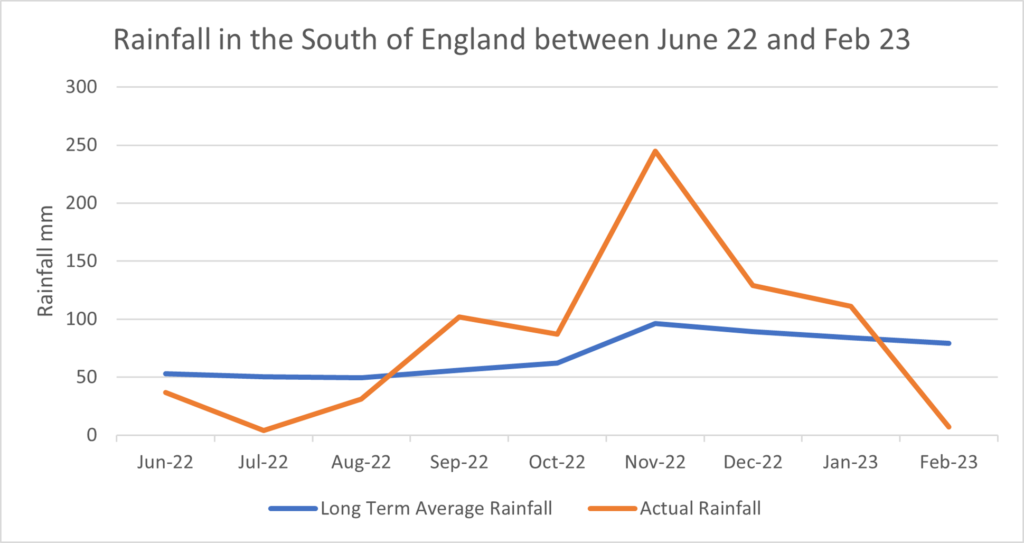
Winter Wheat
Previous cropping can play a big part in estimating residual levels of nitrogen in the soil. Given the nitrogen scavenging ability of Oats, its unsurprising to see such low SMN levels where wheat has followed oats. Surprisingly there is very little difference between Wheat after a pulse crop, maize or second wheats. Where wheat has followed oilseed rape there appears to be a higher residual level of nitrogen. This is likely to be down to the fact that many oilseed rape crops are now being established with some form of organic manure in front of them to help get them away drilling. This residual level may therefore be skewing the results.
Although many growers have already applied nitrogen, it is important to target Wheat after Oats as a priority, shortly followed by second wheats before applying N to the remaining crops. Where crops have been drilled early and are well tillered (Over 1000 shoots/m²), it is likely that these crops have between 20-25kg N/ha within the crop alone. Although these soils will now be beginning to get short of nitrogen it is important not to over feed crops with too much early nitrogen until growth regulators have been applied. However, this will not apply to late drilled crops, and if these have low tiller numbers as well as low soil mineral nitrogen levels it is important to keep these well fed to maintain tiller numbers and ultimately yield potential.
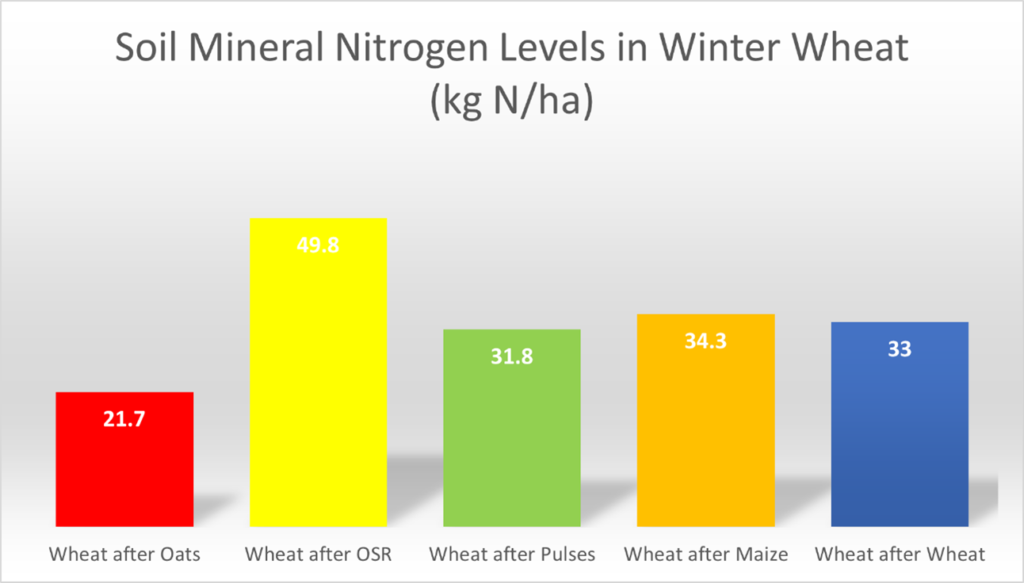
How much Nitrogen should I apply?
Ultimately the amount of nitrogen you should apply comes down to your SNS level, your yield potential, and the protein level you wish to achieve. With volatile wheat and nitrogen markets, it is important to also make sure you are achieving the economic optimum. This may give an opportunity to cut back where feed wheats are grown.
Milling Wheats
If you are wanting to grow milling wheats to a 13% protein, it is very difficult to cut back total nitrogen rates and achieve protein. Therefore the advice is to grow as you would normally. Last year growers that cut back nitrogen levels suffered with lower proteins as a result. The market is still keen for milling wheat, however the premiums will have to reflect the price to get there. If milling wheat premiums are low, it may not be worth the extra cost and risk to get there. If premiums next year are at the current price of £50-60/T, then achieving protein levels will help to increase the gross margin significantly.
Varietal choice will also play a key role in deciding total nitrogen dose. A variety such as Crusoe is more efficient at converting nitrogen into grain protein than the likes of Skyfall, Zyatt, and Illustrious. With the increase in nitrogen prices varieties such as Crusoe have taken a larger market share again.
Feed Wheats
If there are no minimum protein levels set on feed wheat or biscuit wheat contracts then there is scope to reduce nitrogen rates from the farms standard. This will largely depend on what you paid for your nitrogen and what the price of wheat sold at is. The price of wheat will massively influence the economic optimum. Some growers may have sold forward on the futures markets, and can therefore adjust accordingly, however given the current state of affairs it is hard to know where grain prices will be next summer.
The graph below, with data taken from the AHDB may help to aid any decision making. At the current grain price, in most situations the break-even ratio for feed wheats will be around 7 to 9. This means a 20-40 kg N/ha reduction could be made. Therefore feed wheats are likely to require around 180-210kg N/ha. However Milling wheats are still likely to require 280-300kg N/ha to achieve protein.

Oilseed Rape
 There is once again a huge variability in crops with canopy size and larvae numbers and therefore predicting yield potential is difficult. Many early drilled crops have high larval number, however if the crop is well established and can grow away from the damage this may not affect yields. Where crops struggle to get away this spring, yield potential is likely to be at risk and reducing the amount of total N applied should be considered. Early nitrogen applications and early spring vigour appear to be key to beat larval damage.
There is once again a huge variability in crops with canopy size and larvae numbers and therefore predicting yield potential is difficult. Many early drilled crops have high larval number, however if the crop is well established and can grow away from the damage this may not affect yields. Where crops struggle to get away this spring, yield potential is likely to be at risk and reducing the amount of total N applied should be considered. Early nitrogen applications and early spring vigour appear to be key to beat larval damage.
Where crops are under normal growing conditions, nitrogen recommendations will be tailored around canopy size. On average, OSR crops have entered this spring with an estimated 40.2 kg N/ha in the crop alone. This is less than normal and may be as a result of the hard frosts knocking crops back, as well as a shift to later sowings. Early nitrogen applications will therefore be key to help get the crops away from CSFB Larvae and Pigeon damage.
Later sown crops and those that have not had sewage sludge/digestate applied last autumn are still likely to need full nitrogen programmes to optimise yield. Despite the price of OSR coming back, it will be hard to justify any cut back in nitrogen if the green area index is small, especially given the premiums for oils. If crop canopies are large and the crop is growing away well, reductions in nitrogen applications could be considered.
As agronomists, we base nitrogen applications on the amount of nitrogen needed by the crop to achieve optimum canopy of 3.5 GAI by yellow bud, and then adjust totals on the yield expectation of the crop (30kg N/ha additional for every 0.5t over 3.5t/ha) . Invariably this depends on pest damage and how early the crop begins to grow in the spring with the aim of maximising the GAI by flowering. Where it is believed a yield decline is likely due to cabbage stem flea beetle larvae, it may be worth cutting nitrogen rates back.

Spring Crops
Where spring crops are concerned the level of nitrogen applied will depend on the crop type, manure applications and how it was managed over the winter. Stubble turnips and cover crops are becoming more popular as a means to reduce nitrate leaching over the winter and improve soil health.
Where cover crops have been used, SMN levels tends to be higher, however it is difficult to know how much nitrogen will be released as the cover crop breaks down if it is only sprayed off. If it has been grazed this is usually returned in a more available form.
When analysing the data between stubble turnips and standard cover crops, it would appear stubble turnips have a high SMN going into this spring. Some of this may be accountable to the fact that many stubble turnips will receive an application of nitrogen in the summer to help improve bulb size.
After stubble turnips that have been grazed it may be advisable to cut back nitrogen rates slightly (i.e. 20-30kg N/ha), especially if spring malting barley is being grown.
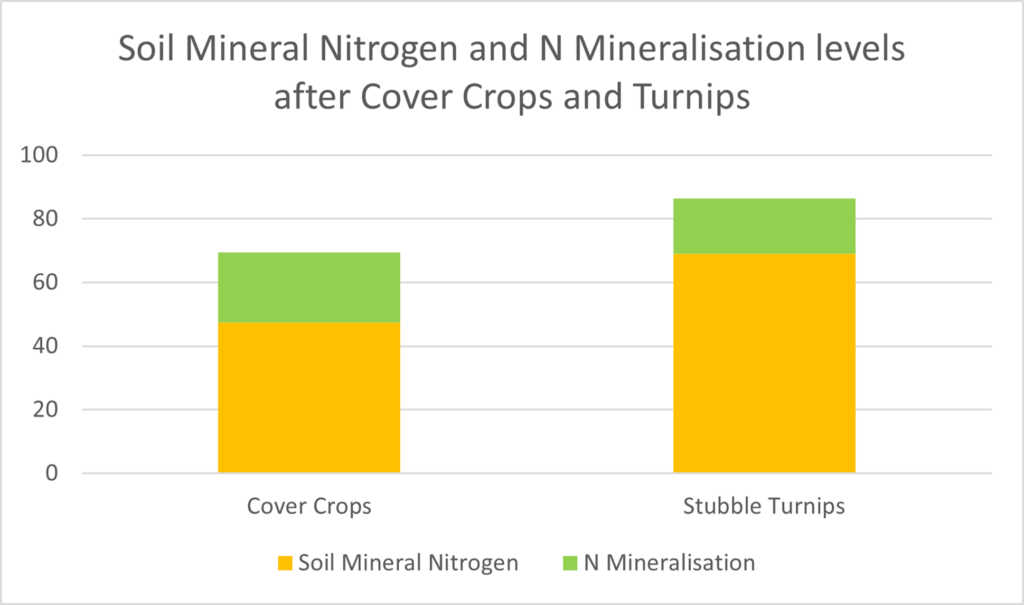
Manures
Manures obviously have many benefits for soils and crops such as increasing soil organic matter, feeding soil microorganisms, increasing water holding capacity, providing a valuable range of nutrients. Where manures have been applied a reduction in the amount of bagged P and K as well as nitrogen inputs can be made.
Every type of manure is different in analysis, but on average where manures have been applied in the last 12 months, SMN and N mineralisation levels are around 9kg N/ha higher. This should therefore be considered in the overall nutrient management plan of the farm, and appropriate reductions may be possible even if the manure was applied to the previous crop.
Manures obviously have many benefits for soils and crops such as increasing soil organic matter, feeding soil microorganisms, increasing water holding capacity, as well as providing a valuable range of nutrients. Where manures have been applied a reduction in the amount of bagged P and K as well as nitrogen inputs can be made.
Every type of manure is different in analysis, but on average where manures have been applied in the last 12 months, SMN and N mineralisation levels are around 9kg N/ha higher. This should therefore be considered in the overall nutrient management plan of the farm, and appropriate reductions may be possible even if the manure was applied to the previous crop.
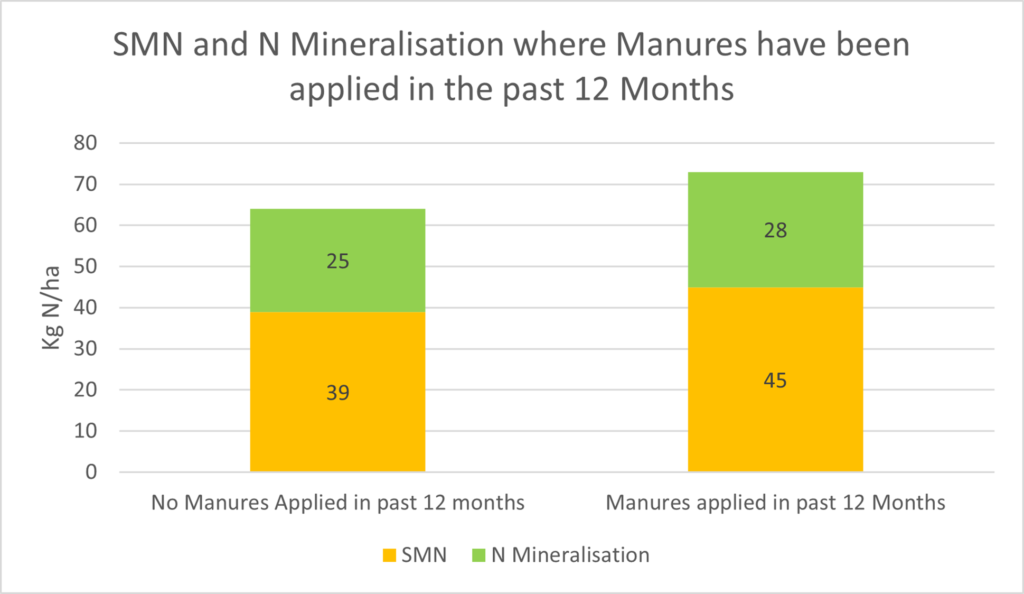
With the changes to the farming rules for water last year making the rules much more workable, its important that as growers we do everything possible to abide by the rules and to ensure good agricultural and environmental practice.
The new rules state that applications should only be made to crop requirements, and it is therefore advised that growers ensure applications are made appropriately. Regular soil sampling should be undertaken and it is advised that growers avoid manure applications where phosphate levels are at Index 3 or above unless there are rotational constraints.
Every type of manure varies significantly in analysis and it is therefore important that farms get manures analysed regularly to know exactly what nutrients are being applied. Please contact us if you wish to have any samples sent off.
Urea Update
Last year Defra ran a consultation to reduce the amount of ammonia emissions from urea fertiliser. The consolation ended in January 2022 and implementations were delayed for a year given the global uncertainties.
Under the new approach, the Red Tractor Farm assurance scheme has opted to bring in new rulings which are to:
- restrict use of untreated urea from 15 January to the end of March each year.
- use urea treated with a urease inhibitor to reduce ammonia emissions throughout the year.
The effectiveness of the scheme will be monitored from this autumn. And therefore growers selling any product through the Red Tractor farm assurance scheme will need to ensure they are up to scratch with the new rules.
When buying new season fertiliser, if opting for Urea it is important to make sure any untreated product is applied before the end of march, and the remaining product is treated with a Urease inhibitor such as Limus or SustaiN.
It is highly likely greater regulation will be introduced if the scheme does not achieve the ammonia reductions needed.
Key messages for 2023
- Soil Mineral Nitrogen levels are lower then average this year, so the potential to cut back may be limited.
- Nitrogen levels within early sown crops are high this spring, leading to an increased lodging risk.
- Oilseed rape, Wheat after Oats and backward crops should be a priority for early nitrogen applications this year.
- With spring malting barley drilling already underway this year it is important to get nitrogen into the seed bed. Don’t apply too much too early, but aim to get the remainder on by 3 leaves of the crop.
- Total nitrogen rates should be adjusted for end market, the grain price and the price paid for nitrogen. Cutting back on milling wheats could be costly.
This document can also form part of your Cross Compliance evidence to demonstrate that you are meeting the NVZ requirement to assess your Soil Nitrogen Status before applying fertiliser.

